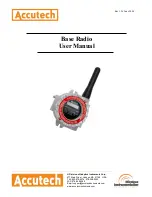
䊳
An optimum measuring point has a uniformly shaped cross-section with an
even velocity distribution and a stable position of the maximum surface velocity.
䊳
Avoid large metallic surfaces close to the sensor radar footprint (reflections
from these surfaces can falsify the measured result).
䊳
Table for determining the approximate size of the sensor radar footprint:
Height "h" Distance "a" Tilt angle 30° Distance"a" Tilt angle 45°
[m] [m] l x w [m] [m] l x w [m]
1.0 1.7 2.0 x 0.4 1.0 0.9 x 0.3
2.0 3.5 3.9 x 0.8 2.0 1.8 x 0.6
3.0 5.2 5.9 x 1.3 3.0 2.7 x 0.9
4.0 6.9 7.9 x 1.7 4.0 3.6 x 1.2
5.0 8.7 9.8 x 2.1 5.0 4.5 x 1.5
7.5 13.0 14.8 x 3.2 7.5 6.7 x 2.2
10.0 17.3 19.7 x 4.2 10.0 8.9 x 3.0
12.5 21.7 24.6 x 5.3 12.5 11.1 x 3.7
15.0 26.0 29.5 x 6.3 15.0 13.4 x 4.5
17.5 30.3 34.4 x 7.4 17.5 15.6 x 5.2
20.0 34.6 39.3 x 8.4 20.0 17.8 x 5.9
22.5 39.0 44.3 x 9.5 22.5 20.0 x 6.7
25.0 43.3 49.2 x 10.5 25.0 22.3 x 7.4
For definitions of height "h" distance "a", "l" and "w", see Figures 6 and 7.
The specified figures are minimum dimensions. Where possible, select a signi -
ficantly larger obstruction-free area.
✓
✗
✗
l
w
Fig. 6: Optimum alignment of sensor radar
footprint with waterway flow direction and
dimensions of radar footprint.
10
Summary of Contents for SVR 100
Page 1: ...English Operating Instructions Surface Velocity Radar OTT SVR 100...
Page 2: ...We reserve the right to make technical improvements...
Page 34: ......
Page 35: ......











































